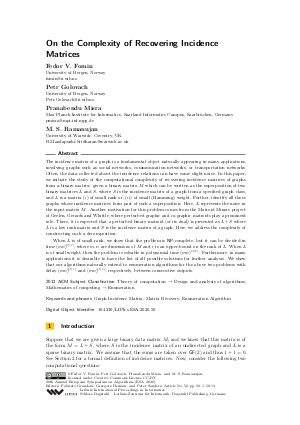On the Complexity of Recovering Incidence Matrices
Authors Fedor V. Fomin, Petr Golovach, Pranabendu Misra, M. S. Ramanujan
-
Part of:
Volume:
28th Annual European Symposium on Algorithms (ESA 2020)
Part of: Series: Leibniz International Proceedings in Informatics (LIPIcs)
Part of: Conference: European Symposium on Algorithms (ESA) - License:
 Creative Commons Attribution 3.0 Unported license
Creative Commons Attribution 3.0 Unported license
- Publication Date: 2020-08-26
File

PDF
LIPIcs.ESA.2020.50.pdf
- Filesize: 0.58 MB
- 13 pages
Document Identifiers
Subject Classification
ACM Subject Classification
- Theory of computation → Design and analysis of algorithms
- Mathematics of computing → Enumeration
Keywords
- Graph Incidence Matrix
- Matrix Recovery
- Enumeration Algorithm
Metrics
- Access Statistics
-
Total Accesses (updated on a weekly basis)
0Document
0Metadata
Abstract
The incidence matrix of a graph is a fundamental object naturally appearing in many applications, involving graphs such as social networks, communication networks, or transportation networks. Often, the data collected about the incidence relations can have some slight noise. In this paper, we initiate the study of the computational complexity of recovering incidence matrices of graphs from a binary matrix: given a binary matrix M which can be written as the superposition of two binary matrices L and S, where S is the incidence matrix of a graph from a specified graph class, and L is a matrix (i) of small rank or, (ii) of small (Hamming) weight. Further, identify all those graphs whose incidence matrices form part of such a superposition. Here, L represents the noise in the input matrix M. Another motivation for this problem comes from the Matroid Minors project of Geelen, Gerards and Whittle, where perturbed graphic and co-graphic matroids play a prominent role. There, it is expected that a perturbed binary matroid (or its dual) is presented as L+S where L is a low rank matrix and S is the incidence matrix of a graph. Here, we address the complexity of constructing such a decomposition. When L is of small rank, we show that the problem is NP-complete, but it can be decided in time (mn)^O(r), where m,n are dimensions of M and r is an upper-bound on the rank of L. When L is of small weight, then the problem is solvable in polynomial time (mn)^O(1). Furthermore, in many applications it is desirable to have the list of all possible solutions for further analysis. We show that our algorithms naturally extend to enumeration algorithms for the above two problems with delay (mn)^O(r) and (mn)^O(1), respectively, between consecutive outputs.
Cite As Get BibTex
Fedor V. Fomin, Petr Golovach, Pranabendu Misra, and M. S. Ramanujan. On the Complexity of Recovering Incidence Matrices. In 28th Annual European Symposium on Algorithms (ESA 2020). Leibniz International Proceedings in Informatics (LIPIcs), Volume 173, pp. 50:1-50:13, Schloss Dagstuhl – Leibniz-Zentrum für Informatik (2020)
https://doi.org/10.4230/LIPIcs.ESA.2020.50
BibTex
@InProceedings{fomin_et_al:LIPIcs.ESA.2020.50,
author = {Fomin, Fedor V. and Golovach, Petr and Misra, Pranabendu and Ramanujan, M. S.},
title = {{On the Complexity of Recovering Incidence Matrices}},
booktitle = {28th Annual European Symposium on Algorithms (ESA 2020)},
pages = {50:1--50:13},
series = {Leibniz International Proceedings in Informatics (LIPIcs)},
ISBN = {978-3-95977-162-7},
ISSN = {1868-8969},
year = {2020},
volume = {173},
editor = {Grandoni, Fabrizio and Herman, Grzegorz and Sanders, Peter},
publisher = {Schloss Dagstuhl -- Leibniz-Zentrum f{\"u}r Informatik},
address = {Dagstuhl, Germany},
URL = {https://drops.dagstuhl.de/entities/document/10.4230/LIPIcs.ESA.2020.50},
URN = {urn:nbn:de:0030-drops-129164},
doi = {10.4230/LIPIcs.ESA.2020.50},
annote = {Keywords: Graph Incidence Matrix, Matrix Recovery, Enumeration Algorithm}
}
Author Details
- Max Planck Institute for Informatics, Saarland Informatics Campus, Saarbrücken, Germany
References
- Emmanuel J. Candès, Xiaodong Li, Yi Ma, and John Wright. Robust principal component analysis? J. ACM, 58(3):11:1-11:37, 2011. URL: https://doi.org/10.1145/1970392.1970395.
- Venkat Chandrasekaran, Sujay Sanghavi, Pablo A. Parrilo, and Alan S. Willsky. Rank-sparsity incoherence for matrix decomposition. SIAM Journal on Optimization, 21(2):572-596, 2011. URL: https://doi.org/10.1137/090761793.
-
Reinhard Diestel. Graph theory, volume 173 of Graduate Texts in Mathematics. Springer-Verlag, Berlin, 3rd edition, 2005.

- Fedor V Fomin, Petr A Golovach, Daniel Lokshtanov, Saket Saurabh, and Meirav Zehavi. Covering vectors by spaces in perturbed graphic matroids and their duals. arXiv preprint, 2019. URL: http://arxiv.org/abs/1902.06957.
-
Jim Geelen, Bert Gerards, and Geoff Whittle. On rota’s conjecture and excluded minors containing large projective geometries. Journal of Combinatorial Theory, Series B, 96(3):405-425, 2006.

-
Jim Geelen and Rohan Kapadia. Computing girth and cogirth in perturbed graphic matroids. Combinatorica, 38(1):167-191, 2018.

- Chien-Chung Huang, Naonori Kakimura, and Naoyuki Kamiyama. Exact and approximation algorithms for weighted matroid intersection. In Proceedings of the Twenty-Seventh Annual ACM-SIAM Symposium on Discrete Algorithms, SODA 2016, Arlington, VA, USA, January 10-12, 2016, pages 430-444, 2016. URL: https://doi.org/10.1137/1.9781611974331.ch32.
- Daniel Lokshtanov, Pranabendu Misra, Fahad Panolan, and Saket Saurabh. Deterministic truncation of linear matroids. ACM Trans. Algorithms, 14(2):14:1-14:20, 2018. URL: https://doi.org/10.1145/3170444.
-
James G. Oxley. Matroid theory, volume 21 of Oxford Graduate Texts in Mathematics. Oxford University Press, 2nd edition, 2010.

-
Nauman Shahid, Nathanael Perraudin, Vassilis Kalofolias, Gilles Puy, and Pierre Vandergheynst. Fast robust pca on graphs. IEEE Journal of Selected Topics in Signal Processing, 10(4):740-756, 2016.

- John Wright, Arvind Ganesh, Shankar R. Rao, YiGang Peng, and Yi Ma. Robust principal component analysis: Exact recovery of corrupted low-rank matrices via convex optimization. In Proceedings of 23rd Annual Conference on Neural Information Processing Systems (NIPS), pages 2080-2088. Curran Associates, Inc., 2009. URL: http://papers.nips.cc/paper/3704-robust-principal-component-analysis-exact-recovery-of-corrupted-low-rank-matrices-via-convex-optimization.
-
Mengnan Zhao, M Devrim Kaba, René Vidal, Daniel P Robinson, and Enrique Mallada. Sparse recovery over graph incidence matrices. In 2018 IEEE Conference on Decision and Control (CDC), pages 364-371. IEEE, 2018.

